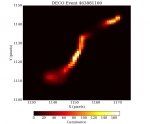Monday, October 29, 2018 - 10:15am
Ok, so you’ve completed that giant 18,000-piece jigsaw puzzle, now what? Well, you might not want to take it apart again, at least not for a while. The folks at the South Pole decided to give theirs a place of honor on the wall in the B2 science lab.
Wednesday, October 24, 2018 - 3:30pm
In a new measurement published recently in The Astrophysical Journal, HAWC has looked deeper into the region between 2 and 73 TeV and has also studied the large-scale anisotropy and the energy dependence between both the small- and large-scale features.
Friday, October 19, 2018 - 1:00pm
Bad weather at the Pole last week kept the first flights from arriving, but it also meant lots of snow shoveling and fuel line testing to continue their readiness for incoming flights once conditions do improve.
Friday, October 12, 2018 - 9:30am
While they wait at the Pole for the first arriving flights of the season, there are still chores to do, like snow removal. The snowcat in this image is poised for action.
Friday, October 5, 2018 - 1:00pm
The main entrance to the South Pole station is known as Destination Alpha—this image shows a view out onto the frosty tundra from there at early sunrise.
Thursday, October 4, 2018 - 10:45am
The launch of the so-called IceCube Upgrade—which will deploy seven new strings at the bottom of the detector array—sets a milestone in what IceCubers have designed as an incremental extension of the Antarctic detector.
Wednesday, October 3, 2018 - 2:00pm
For the first time, an international collaboration of scientists has detected extremely high-energy gamma rays, the most powerful type of light, coming from the outermost regions of an unusual star system within our own galaxy. The source is microquasar SS 433, a black hole that gobbles up stuff from a nearby companion star and blasts out powerful jets of material. The team’s observations, described in the October 4 issue of the journal Nature, represent the most energetic radiation ever detected from a microquasar in our galaxy.
Tuesday, October 2, 2018 - 3:00pm
A team of researchers at the University of Wisconsin–Madison has developed an algorithm for identifying images of cosmic rays taken by smartphone cameras. The new algorithm uses data from the Distributed Electronic Cosmic-ray Observatory (DECO), a smartphone application that uses the phone’s camera sensor to detect cosmic rays and other energetic particles.
Friday, September 28, 2018 - 2:00pm
The equinox occurred last week, and the sun has finally risen above the horizon. The sky in turn is showing off an array of beautiful colors, providing a nice backdrop for outdoor photos.
Friday, September 21, 2018 - 1:00pm
Just because the sun’s coming up, doesn’t mean it’s getting warmer yet. In fact, they’ve had some tremendously cold days at the Pole, with the thermometer hitting –100 F last week.










